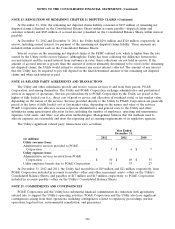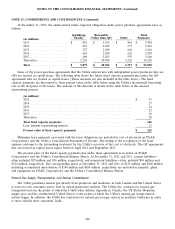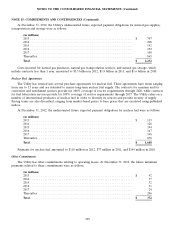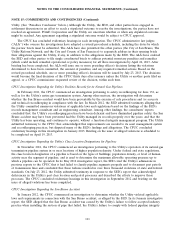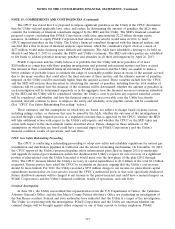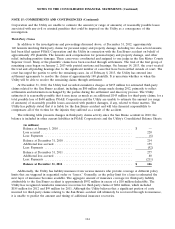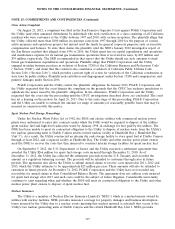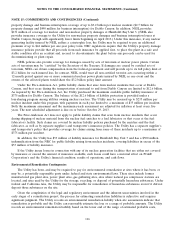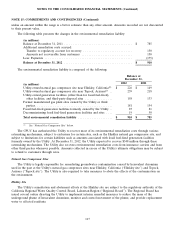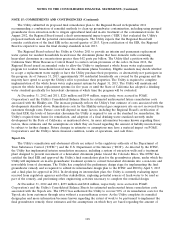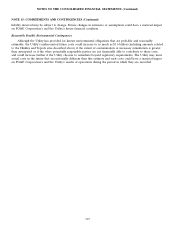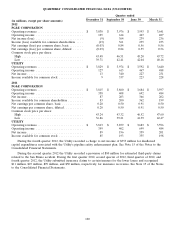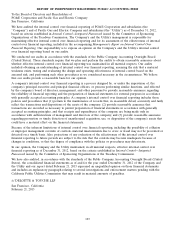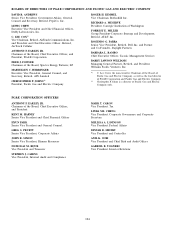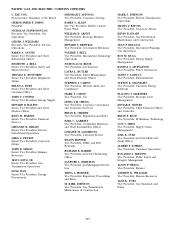PG&E 2012 Annual Report Download - page 120
Download and view the complete annual report
Please find page 120 of the 2012 PG&E annual report below. You can navigate through the pages in the report by either clicking on the pages listed below, or by using the keyword search tool below to find specific information within the annual report.NOTES TO THE CONSOLIDATED FINANCIAL STATEMENTS (Continued)
NOTE 15: COMMITMENTS AND CONTINGENCIES (Continued)
property damage and business interruption coverage of up to $3.2 billion per nuclear incident ($2.7 billion for
property damage and $490 million for business interruption) for Diablo Canyon. In addition, NEIL provides
$131 million of coverage for nuclear and non-nuclear property damages at Humboldt Bay Unit 3. (NEIL also
provides insurance coverage to the Utility for non-nuclear property damages and business interruption losses at
Diablo Canyon, though with significantly lower limits beginning in April 2013.) Under this insurance, if any nuclear
generating facility insured by NEIL suffers a catastrophic loss, the Utility may be required to pay an additional
premium of up to $44 million per one-year policy term. NRC regulations require that the Utility’s property damage
insurance policies provide that all proceeds from such insurance be applied, first, to place the plant in a safe and
stable condition after an accident and, second, to decontaminate the plant before any proceeds can be used for
decommissioning or plant repair.
NEIL policies also provide coverage for damages caused by acts of terrorism at nuclear power plants. Certain
acts of terrorism may be ‘‘certified’’ by the Secretary of the Treasury. If damages are caused by certified acts of
terrorism, NEIL can obtain compensation from the federal government and will provide up to its full policy limit of
$3.2 billion for each insured loss. In contrast, NEIL would treat all non-certified terrorist acts occurring within a
12-month period against one or more commercial nuclear power plants insured by NEIL as one event and the
owners of the affected plants would share the $3.2 billion policy limit amount.
Under the Price-Anderson Act, public liability claims that arise from nuclear incidents that occur at Diablo
Canyon, and that occur during the transportation of material to and from Diablo Canyon are limited to $12.6 billion.
As required by the Price-Anderson Act, the Utility purchased the maximum available public liability insurance of
$375 million for Diablo Canyon. The balance of the $12.6 billion of liability protection is provided under a
loss-sharing program among utilities owning nuclear reactors. The Utility may be assessed up to $235 million per
nuclear incident under this program, with payments in each year limited to a maximum of $35 million per incident.
Both the maximum assessment and the maximum yearly assessment are adjusted for inflation at least every five
years. The next scheduled adjustment is due on or before October 29, 2013.
The Price-Anderson Act does not apply to public liability claims that arise from nuclear incidents that occur
during shipping of nuclear material from the nuclear fuel enricher to a fuel fabricator or that occur at the fuel
fabricator’s facility. Such claims are covered by nuclear liability policies purchased by the enricher and the fuel
fabricator, as well as by separate supplier’s and transporter’s insurance policies. The Utility has a separate supplier’s
and transporter’s policy that provides coverage for claims arising from some of these incidents up to a maximum of
$375 million per incident.
In addition, the Utility has $53 million of liability insurance for Humboldt Bay Unit 3 and has a $500 million
indemnification from the NRC for public liability arising from nuclear incidents, covering liabilities in excess of the
$53 million of liability insurance.
If the Utility incurs losses in connection with any of its nuclear generation facilities that are either not covered
by insurance or exceed the amount of insurance available, such losses could have a material effect on PG&E
Corporation’s and the Utility’s financial condition, results of operations, and cash flows.
Environmental Remediation Contingencies
The Utility has been, and may be required to pay for environmental remediation at sites where it has been, or
may be, a potentially responsible party under federal and state environmental laws. These sites include former
manufactured gas plant sites, power plant sites, gas gathering sites, sites where natural gas compressor stations are
located, and sites used by the Utility for the storage, recycling, or disposal of potentially hazardous substances. Under
federal and California laws, the Utility may be responsible for remediation of hazardous substances even if it did not
deposit those substances on the site.
Given the complexities of the legal and regulatory environment and the inherent uncertainties involved in the
early stages of a remediation project, the process for estimating remediation liabilities is subjective and requires
significant judgment. The Utility records an environmental remediation liability when site assessments indicate that
remediation is probable and the Utility can reasonably estimate the loss or a range of probable amounts. The Utility
records an environmental remediation liability based on the lower end of the range of estimated probable costs,
116


